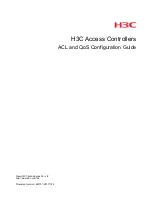
Chapter 5 Packet Operation
USers
n
Default: 1
Mode: packet
Host: UR
“n”
0 to 10 specifies the number of active simultaneous connections that can be established with your DSP.
USERS
affects the way that
incoming
connect requests are handled. It doesn’t affect the number of
outgoing
connections you initiate. For example:
USERS
0
Allows incoming connections on any free channel
USERS
1
Rejects incoming connections if there are connections on 1 or more channels.
USERS
2
Rejects incoming connections if there are connections on 2 or more channels.
USERS
3
Rejects incoming connections if there are connections on 3 or more channels.
...and so on, through
USERS
10
.
WHYnot
ON
|
OFF
Default: OFF
Mode: packet
Host: WN
ON
The DSP generates a reason why received packets weren’t displayed.
OFF
This function is disabled.
During packet operation, the DSP may receive many packets that aren’t displayed. Turning
WHYNOT
on will
cause the DSP to generate a message explaining the reason why the received packet wasn’t displayed. The messages
and their meanings are:
PASSALL:
The received packet frame had errors, and
PASSALL
was
OFF
, preventing
the packet from being displayed to the screen.
DCD Threshold:
The Threshold control was set too far counter-clockwise. The DCD LED
was off when the packet was received.
MONITOR:
The
MONITOR
value was set too low to receive this frame.
MCON:
MCON
was set too low to receive this type of frame.
MPROTO:
MPROTO
was set to
OFF
, and the received packet was probably a
NET/ROM or TCP/IP frame.
MFROM/MTO:
The frame was blocked by the
MFROM
or
MTO
command.
MBX:
The callsign of the sending station doesn’t match the callsign setting in the
MBX
command.
MBX Sequence:
The frame was received out of sequence, probably a retry.
Frame too long:
Incoming packet frame longer than 330 bytes. Probably a non-AX.25
frame.
Frame too short:
Incoming packet frame shorter than 15 bytes. (Only seen if
PASSALL
is
ON
—probably noise.)
RX overrun:
Another HDLC byte was received before the DSP could read the previous
one out of the HDLC chip.
September, 05
5-47
Summary of Contents for DSP-232
Page 120: ...Chapter 6 GPS Applications September 05 6 1...
Page 138: ...Chapter 7 Maildrop Operation 7 18 September 05...
Page 158: ......
Page 159: ...Chapter 8 ASCII and Baudot Operation September 05 8 1...
Page 185: ......
Page 186: ...Chapter 9 AMTOR Operation September 05 9 1...
Page 198: ......
Page 199: ...Chapter 10 Morse Operation September 05 10 1...
Page 207: ......
Page 208: ...Chapter 11 SIAM and NAVTEX Operation September 05 11 1...
Page 230: ......
Page 231: ...Chapter 12 PACTOR Operation September 05 12 1...
Page 240: ...Chapter 13 Troubleshooting September 05 13 9...
Page 254: ...Chapter 13 Troubleshooting 13 9...
Page 256: ...DSP 232 Manual Addendum September 05 AD 2...
Page 259: ...Appendix A Radio Connections Radio Connection Diagrams September 05 A 3...
Page 260: ...Appendix A Radio Connections A 4 September 05...
Page 261: ...Appendix A Radio Connections September 05 A 5...
Page 262: ...Appendix A Radio Connections A 6 September 05...
Page 263: ...Appendix A Radio Connections September 05 A 7...
Page 267: ...Appendix D Mailbox Upgrade September 05 D 2...
Page 268: ...Appendix E Schematics and Pictorial September 05 E 3...
















































